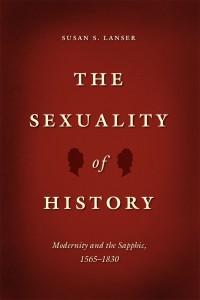 The Sexuality of History: Modernity
The Sexuality of History: Modernity
and the Sapphic, 1565-1830
by Susan S. Lanser
University of Chicago Press
344 pages, $95. (paperback $32.50)
THE AUTHOR of this book defends a daring hypothesis. Her argument, which is supported by considerable research, is that “sapphic” relationships between women, both real and imagined, belong not at the margins but at the center of Western cultural history.
In the first chapter of The Sexuality of History—a play on Michel Foucault’s famous title, The History of Sexuality—Susan S. Lanser argues that the basic trappings of modern Western civilization, everything from eating with forks to the “rights of man,” first appeared in the 1600s and have been developing since then. She goes on to identify a major factor in these developments: “For reasons which I will argue were intrinsic rather than incidental to these transformations, seventeenth and eighteenth-century Europe also witnessed an intensified interest in lesbians. In genres from scientific treatises to orientalist travelogues, in the gossip of French royal courts and the records of Dutch legal courts, in bawdy poems, domestic fictions, and cross-dressed flirtations on the English and Spanish stage, poets, playwrights, philosophers, and pundits were placing what I call sapphic subjects before the public eye.”
Lanser proposes to rearrange Foucault’s approach to the history of sexuality, which in itself challenged a widespread assumption that human sexuality is “natural” and therefore not subject to historical change. Rather than sifting through historical material to find actual lesbians (female lovers in a sexual sense) or proposing a history of lesbianism, Lanser shows the influence of the formula of “woman + woman” on what is defined as “modern” and “civilized.”
This approach is likely to disappoint lesbian readers who would prefer biographical material about lesbians in history. Some of the material presented by Lanser is clearly about the “sapphic imaginary” as described by those who found primary relationships between women to be unseemly at best. The perceived social threat of “woman + woman” in male-dominated and heterosexually-structured societies is part of Lanser’s argument about social change.
Three patterns in the evidence are identified. Some of the writing presented by Lanser shows a perception of sapphic (to adopt her use of the lower case) relationships as a decadent import from foreign cultures, particularly from Turkey at a time when the Ottoman Empire seemed threatening to Christian Europe. Warnings about “woman + woman” can thus be read as indicators of social change caused by cultural influence, at least as imagined by those who feared it. “Woman + woman” in descriptions of “same-sex” relationships (Lanser’s emphasis) appears radically egalitarian, especially when they appear in more class-divided cultures than our own. Thirdly, “woman + woman” in more complementary roles suggests that at least some women have always been able to learn all the “manly” arts and that actual men have never been as essential to women’s survival as mainstream ideology would have it.
Many visionaries have pointed out that social change has to be imagined before it can be realized. Lanser points out the contradiction between “the insistent labeling of the sapphic as impossibility” in the material under discussion and “the production of that impossibility in text after text.” To a surprising degree, visions of democratic all-female societies, largely composed of satisfied couples, are shown to be the brain-children of men. At the same time, much of the “sapphic imaginary” in this book takes the form of passionate declarations of love by actual women to women, which Lanser describes as “sapphic apostrophe.” This genre apparently reached its peak in the late 1600s, when these publications circulated openly.
The evidence of “sapphic subjects” from the rise of European discovery of other continents to the eve of the Victorian Age is fascinating in itself, and the range of material would probably be hard to find in any other single book. The author attempts to storm the male-dominated bastion of social theory-making in a way that parallels the perceived social intrusion of “woman + woman,” as described by writers of past centuries. This evidence will undoubtedly be dismissed by some as anecdotal. Other readers may be disappointed by the inclusion of much material that does not document actual lesbian lives. However, the author’s argument is both logical and wide-ranging, and the evidence is convincing.
Lanser modestly admits that there is simply no way to discover printed sources that may have disappeared, and researching printed sources in every European language is beyond her ability. What she has compiled is impressive enough. In the concluding chapter, “We Have Always Been Modern,” she points out that the modern project of legally defending the rights of the individual (up to and including same-sex marriage) is far from complete, and it has had many setbacks during the centuries under discussion. As she shows, however, “sapphic subjects” are neither a current invention nor an outdated one.
Jean Roberta is a widely published writer based in Regina, Saskatchewan.






